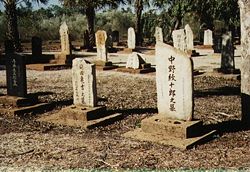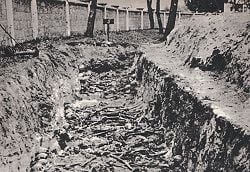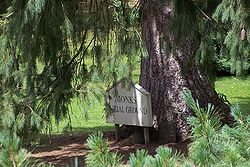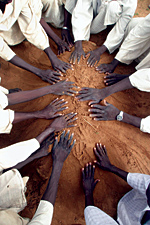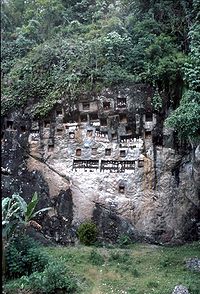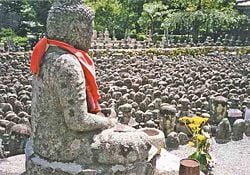Burial
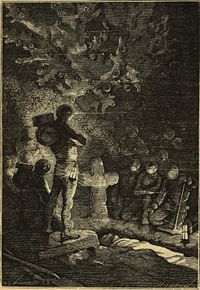
Burial, or the ritual disposal of human remains, is the act of placing a person or object into the ground. This is accomplished by digging a pit or trench, placing the person or object inside, and replacing the soil on top of the site. The most common use of the term burial refers to human burial, or the placement of a body into a tomb or grave within the ground. Human burial prevents the emission of unpleasant odors due to gases released by bacterial decomposition after a body has begun to decay. The first use of human burial can be traced back to the Paleolithic period and is believed to have originated in European caves.
While there are practical reasons and constraints on the methods of burial of dead bodies, the diversity of methods, ceremonies, and so forth found in different cultures and locations around the world primarily reflect religious beliefs concerning death and the afterlife. As human societies have developed, their burial methods and grave markings often remain as evidence of their beliefs, available for study by archaeologists.
Reasons for Burial
Human burial practices are believed to be the manifestation of the human desire to demonstrate "respect for the dead." The practice may also be used to ensure the deceased’s entry into an afterlife. Among many cultures, respect for the physical remains is considered necessary. If a body is to be left lying above ground, scavenging animals may eat the corpse, an act considered highly disrespectful to the deceased in many cultures. Burial can also be seen as an attempt to bring closure to the deceased's family and friends. By interring a body away from plain view, the emotional pain of losing a loved one may often be lessened. While it is not necessarily a public health requirement, burial prevents the living from having to see and smell the decomposing corpse. Contrary to conventional wisdom, the WHO advises that only corpses carrying an infectious disease strictly require burial.[1] [2] Other cultures believed burial to be a necessary step for an individual to reach the afterlife, while other religious cultures may prescribe a "correct" way to live, which includes customs relating to the disposal of the dead.
The act of burying corpses is thought to have begun during the Paleolithic period. Historically, mounds of earth, temples, and underground caverns were used to store the dead bodies of ancestors. In modern times, the custom of burying the dead below ground with a stone marker to mark the place is used in almost every modern culture. Some burial practices are heavily ritualized; others are simply practical.
Methods of Burial
Most burials occur in graves, structures designed to house the remains of the dead dug into a plot of earth. Graves are designed by an initial grave cut which removes a section of earthen topsoil in order for subsequent burial. A vault structure is then often built within the grave to receive the body; such structures are used to prevent the crushing of the remains or to allow for multiple burials, such as a family vault. After the remains have been laid, the soil is returned to the grave to complete the burial process. A monument or general marker, such as a headstone, may then be placed above the grave for identification or celebratory purposes.
Personal effects
In many cultures, the body is dressed in nice or ceremonial clothes. Personal objects, such as a favorite piece of jewelry or photograph, belonging to the deceased may be included with the body. The inclusion of such grave goods serves several purposes. Firstly, in many funeral services, the body is often put on display. Many cultures feel that the deceased should be presented looking his/her finest, and dress the body in such ways. In other cultures, the inclusion of ceremonial garb and sacred objects is sometimes viewed as necessary for reaching the afterlife. The inclusion of personal effects may also be motivated by the beliefs that in the afterlife a person will wish to have in their possession.
Positioning
Buried corpses may be placed in a number of different positions. Christian burials are made extended, with the corpse lying flat with arms and legs straight, or with the arms folded upon the chest. The eyes and mouth of the deceased are kept closed. Extended burials may also be supine, lying on one’s back, or prone, lying on one’s front. Historically, Christian burials were made supine east-west, with the head at the western end of the grave. This mirrors the layout of Christian churches, and for much the same reason; to view the coming of Christ on Judgement day (Eschaton).
Other ritual practices place the body in a flexed position with the legs bent or crouched. In some ancient societies, warriors were buried in an upright position. In Islam, the face of the body is turned toward Mecca, the holiest city in Islam. Many cultures believe the placement of the dead in an appropriate position to be a sign of respect even when burial is impossible. In nonstandard burial practices, such as mass burial, bodies are often positioned arbitrarily. This can be a sign of disrespect to the deceased, or due to considerations of time and space.
Location
Apart from sanitary and other practical considerations, the site of burial can be determined by religious and socio-cultural considerations. In some traditions, especially with an animistic logic, the remains of the dead are "banished" for fear their spirits would harm the living if too close; other cultures may keep the remains close for surviving generations.
Religious rules may also prescribe a specific zone of burial. Within the Christian religion, the deceased must be buried in "consecrated ground," often a cemetery. An earlier Christian practice specifying burial to be in or very near the church, has been generally abandoned with individual exceptions such as a high posthumous honor. Royalty and high nobility often have one or more "traditional" sites of burial, generally monumental, often in a palatial chapel or cathedral.
Burial markings
Most modern cultures mark the location of the body with a headstone. This serves two purposes. First, the grave will not accidentally be exhumed. Second, headstones often contain information or tributes to deceased. This is a form of remembrance for loved ones; it can also be viewed as a form of immortality. Such monumental inscriptions may subsequently be useful to genealogists and family historians. In many cultures graves will be grouped, so the monuments make up a necropolis, or a "city of the dead," paralleling the community of the living.
Embalming
Embalming is the practice of preserving a body against decay, and is used in many cultures. Mummification is a more extensive method of embalming, further retarding the decay process. Bodies are often buried wrapped in a shroud or placed in a coffin. A larger container may be used, such as a ship. Coffins are usually covered by a burial liner or a burial vault, which protects the coffin from collapsing under the weight of the earth or floating away during a flood.
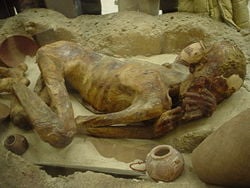
These containers slow the decomposition process by physically blocking decomposing bacteria and other organisms from accessing the corpse. An additional benefit of using containers to hold the body is that if the soil covering the corpse is washed away by a natural process, the corpse will not be exposed to open air.
In some cultures the goal of burial is not to preserve the body but to allow it to decompose or return to the earth naturally. In Orthodox Judaism embalming is not permitted, and the coffins are constructed so that the body will be returned to the earth as soon as possible. Such coffins are made of wood, and have no metal parts at all. Wooden pegs are used in the place of nails. Followers of the Islamic faith also prefer to bury their deceased so as not to delay decomposition. Normally, instead of using coffins, the deceased are buried in a shroud and the bodies of the deceased are not normally embalmed.
Types of Burials
Natural burial
A growing trend in modern burial is the concept of natural burial. Popularized in the United Kingdom in the late 1990s, natural burial is being adopted in the United States as a method for protecting and restoring the natural environment. With a natural burial, the body is returned to nature in a biodegradable coffin or shroud. Native vegetation, often a memorial tree, is planted over or near the grave in place of a conventional monument. The resulting green space establishes a living memorial and forms a protected wildlife preserve. Natural burial grounds are also known as woodland cemeteries, eco-cemeteries, memorial nature preserves, or green burial grounds.
Multiple burials
Some couples or groups of people, such as married couples or family members, may wish to be buried in the same plot. In some cases, the coffins, or urns, may simply be buried side by side. In others, one casket may be interred above another. If this is planned for in advance, the first casket may be buried more deeply than is the usual practice so that the second casket may be placed over it without disturbing the first.
Mass grave burials
Mass burial is the practice of burying multiple bodies in one location. Civilizations attempting genocide often employ mass burial for such victims. However, mass burial may in many cases be the only practical means of dealing with an overwhelming number of human remains, such as those resulting from a natural disaster, an act of terrorism, an epidemic, or an accident. This practice has become less common in the developed world with the advent of genetic testing.
Naval ships sunk in combat are also considered mass graves by many countries. For example, U.S. Navy policy declares such wrecks a mass grave and forbids the recovery of any remains. In lieu of recovery, divers or submersibles leave a plaque dedicated to the memory of the ship or boat and its crew, and family members are invited to attend the ceremony. Sites of large former battlefields may also contain one or more mass graves.
Catacombs also comprise a form of mass grave. Some catacombs, such as the Roman Catacombs, were designated as a communal burial place. Some, such as the catacombs of Paris, only became a mass grave when individual burials were relocated from cemeteries marked for demolition.
Premature burial
Live burial, in which individuals are buried while still alive, has been known to occur. Having no way of escaping interment, they die in place, typically by asphyxiation, dehydration, starvation, or exposure. People may come to be buried alive in a number of different ways. An individual may be intentionally buried alive as a method of execution or murder. A person or group of people in a cave, mine, or other underground area may be sealed underground due to an earthquake or other natural disaster. Live burial may also occur due to avalanches on mountain slopes. In rare cases, people have been unintentionally buried alive because they were pronounced dead by a coroner or other official, when they were in fact still alive.
Animal burials
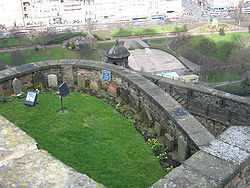
In addition to burying human remains, many cultures also regularly bury animal remains. Pets and other animals of emotional significance are often ceremonially buried. Most families bury deceased pets on their own properties, mainly in a yard, with any type of container serving as a coffin. The Ancient Egyptians are known to have mummified and buried cats, which they considered deities, called Bast or Bastet. Humans are not always the only species to bury their dead. Chimpanzees and elephants are known to throw leaves and branches over fallen members of their family groups.
Cultural Differences and Burial
Various religions and cultures employ distinct burial rituals and ceremonies in the disposal of human remains. For some, the body is carefully preserved and buried with great respect, regarding the physical remains as still important and significant to the individual who has passed into the afterlife. For others, a ritual burning frees the spirit to ascend to its new home in the afterlife. Among the Vikings, water burials or ship burials were prevalent, later including the cremation of bodies and the subsequent scattering of the ashes over water. Variation of this practice were used among many early Asian societies; in India, open air funeral pyres were common along the banks of rivers and the cremated remains were often thrown into the sacred Ganges River.
African American slave tradition
In the African-American slave community, specific slaves were assigned to prepare dead bodies, build coffins, dig graves, and construct headstones. Slave funerals were typically at night when the workday was over, with the master present to view all the ceremonial procedures. Slaves from nearby plantations were regularly in attendance.
At death, a slave’s body was wrapped in cloth. The hands were placed across the chest, and a metal plate was placed on top of their hands. The reasoning for the plate was to hinder their return home by suppressing any spirits in the coffin. Often, personal property was buried with slaves to appease spirits. The coffins were nailed shut once the body was inside, and carried by hand or wagon, depending on the property designated for slave burial site. Slaves were buried east to west, with the head facing east and their feet to the west. This positioning represented the ability to rise without having to turn around at the call of Gabriel’s trumpet. Gabriel’s trumpet would be blown in the eastern sunrise. East-west positioning also marked the direction of home, Africa.
Bahá'í tradition
Bahá'í burial law prescribes both the location of burial and burial practices and precludes cremation of the dead. It is forbidden to carry the body for more than one hour's journey from the place of death. Before interment the body should be wrapped in a shroud of silk or cotton, and a ring should be placed on its finger bearing the inscription I came forth from God, and return unto Him, detached from all save Him, holding fast to His Name, the Merciful, the Compassionate. The coffin should be of crystal, stone, or hard fine wood. Also, before interment, a specific Prayer for the Dead is ordained.[3] The formal prayer and the ring are meant to be used for those who have reached fifteen years of age.[4]
Christian tradition
According to the Christian tradition, the church seeks to provide spiritual support for the deceased and honor their bodies, as well as provide a measure of hope for the family and friends of the deceased. Typically the body of the deceased is waked for a period of two to three days, either at home, or in a church, chapel or funeral home, during which time family and friends pay respect to the dead, pray and keep vigil. Christian burials may make use of a closed or open casket, and the body of the deceased is nicely groomed. Following the final hours of the wake, the body is transported to a cemetery where a ceremony is held in which prayers and scriptures are read. The casket is then placed into the ground; a tombstone or marker is erected above the grave to remember the deceased in life. In some cultures there is no wake, and the body is buried within 24 hours.
Islamic tradition
According to Islamic tradition, disposing of human remains follows a set of very specific rituals and rights. First, the body of the deceased is bathed in order to physically cleanse the corpse before other rituals may begin. The corpse is then enshrouded in coffin cloth, or simple plain cloth known as kafan. This process is known as takfeen and is done to respectfully wrap the corpse so that its private parts are not visible to others. The Muslims of the community then gather to offer their collective prayers for the forgiveness of the dead; this prayer has been generally termed as the Janazah prayer. The grave itself is aligned on a northeast to southwest axis, facing Mecca. The wrapped body is placed directly into the ground, without any kind of casket. The body is laid on its right side, with the head facing Mecca, and the shroud is removed from the face. Only men are allowed to attend the actual graveside service.
Jewish tradition
Under the Jewish religion, bodies of the deceased are never left alone until burial as a sign of respect for the dead; the unburied body is watched over by people known as Shomerin. While watching over the dead, Shomerin are forbade to eat, drink, or perform a commandment in the presence of the dead as to do so would be disrespectful. Under Jewish law, open casket ceremonies are forbidden and the body is never put on display to be viewed after death. The Jewish religion does not practice any form of cremation and all bodies are buried in the earth. Though coffins are not required, if used, they must have holes drilled into them. A prayer known as the Kaddish is often recited at the gravesite of the deceased and a burial marker is erected one year later. [5]
Korean tradition
Within Korean culture, bodies of the deceased are treated with the utmost care. If possible, the deceased man or woman passes in the afterlife in one’s home surrounded by family and friends. If the deceased is a man, no woman is permitted to view the body; if the deceased is a woman, no man is permitted to view the body. A wake may last anywhere from three to nine days in which both breakfast and dinner are prepared for visitors and the deceased. During this period the coffin is heavily decorated and the body finely groomed; the remaining particles such as cut fingernails, toenails, or hair are buried with the deceased.[6]
Nuer tradition
Under the Nuer tradition of Eastern Africa, the bodies of the deceased are buried as soon as possible. Only family members are allowed to attend the burial ceremony in which a particularly religious member of the family makes a sacrifice to prevent the spirit of the deceased from haunting living family members thereafter; this sacrifice is made to prevent further misfortune from plaguing the family of the deceased. No rituals occur at the grave and no ornaments are buried with the body. The mourning process must be completed within five to six days for the death of a man, and two to three for the death of any woman or child.[7]
Toraja tradition
In Toraja society, the funeral ritual is the most elaborate and expensive event. The richer and more powerful the individual, the more expensive is the funeral. The ceremony is often held weeks, months, or years after the death so that the deceased's family can raise the significant funds needed to cover funeral expenses. One component of the memorial ritual is the slaughter of water buffalo; the more powerful the person who died, the more buffalo are slaughtered at the death feast. Slaughtering tens of water buffalo and hundred of pigs using a machete is the climax of the elaborate death feast, with dancing and music and young boys who catch the spurting blood in long bamboo tubes.
Upon burial the coffin may be laid in a cave or in a carved stone grave, or hung on a cliff. It contains any possessions that the deceased will need in the afterlife. The wealthy are often buried in a stone grave carved out of a rocky cliff. The coffin of a baby or child may be hung from ropes on a cliff face or from a tree. This hanging grave usually lasts for years, until the ropes rot and the coffin falls to the ground.
Exhumation
The digging up of a buried body is called exhumation, and is considered sacrilege by most cultures that bury their dead. However, there do exist a number of circumstances in which exhumation is tolerated. If an individual is believed to have died under suspicious circumstances, a legitimate investigating agency, such as the coroner's office or a police agency, may exhume the body to determine the cause of death. Deceased individuals who were either not identified or misidentified at the time of burial may also be exhumed if survivors so wish.[8] Certain remains may also be exhumed in order to be re-interred at a more appropriate location. For example, the remains of Nicholas II of Russia and his family were exhumed from their resting place near Yekaterinburg so that they could be re-interred in the Peter and Paul Fortress in Saint Petersburg, Russia.
Remains may also be exhumed and reburied en masse when a cemetery is relocated.[9] In rare cases, such as that of Oliver Cromwell, a body may be exhumed for posthumous execution or dissection. The remains of various historical figures of note may also be exhumed in order to ascertain the answers to certain historical questions. Egyptian Pharaoh Tutankhamen's remains were exhumed in 2005 in order to determine his cause of death.
Once human remains reach a certain age many cultures consider the remains to have no communal provenance, making exhumation acceptable. This serves several purposes including the reallocation of land within overcrowded cemeteries. Once all plots are full, older remains are typically moved to an ossuary to accommodate more bodies. This type of exhumation may also occur to enable archaeologists to search for human remains in order to better understand human culture.
Alternatives to Burial
Human bodies are not always buried, and many cultures may not bury their dead in every case. Most alternatives to burial are still intended to maintain respect for the dead, but some are intended to prolong the display of remains. Within an alternative ceremony known as an Ash jump, skydivers often elect to have their cremated remains released by their loved ones during freefall.
Funerary cannibalism, another alternative to burial, is the practice of eating the bodily remains. This may be for many reasons, for example to partake of the departed's strength, to spiritually "close the circle" by reabsorbing their life, to annihilate an enemy, or due to pathological mental conditions. The Yanomami have the habit of cremating the remains and then eating the ashes with banana paste.
Cremation, one of the more popular alternatives to burial, is the incineration of the remains at high temperatures. Most of the body is burnt during the cremation process, leaving only a few pounds of bone fragments. Often these fragments are processed into a fine powder, which has led to cremated remains being called "ashes." The ashes can also be buried either underground or in a columbarium niche.
Excarnation is the practice of removing the flesh from the corpse without interment. The Zoroastrians have traditionally left their dead on Towers of Silence, where the flesh of the corpses is let to be devoured by vultures and other carrion-eating birds. Alternatively, it can also mean butchering the corpse by hand to remove the flesh, a practice sometimes referred to as "defleshing." The ancient practice of Gibbeting, the practice of publicly displaying the remains of criminals, was also used as an alternative to burial. Other forms include Hanging coffins which are coffins placed on cliffs. They can be found in various locations, including China and the Philippines. Similarly, the practice of Sky burial involves placing the body on a mountaintop.
Burials at sea involve the practice of depositing a body into an ocean or other large body of water instead of soil. In such circumstances, the body may be disposed in a coffin, or without one.
Space burial is the practice of firing the coffin into space; the coffin may be placed into orbit, sent off into space, or incinerated in the sun. Space burial is still largely in the realm of science fiction as the cost of getting a body into space is prohibitively large, although several prominent figures have had a sample of their ashes launched into space after cremation.
Notes
- ↑ Oliver Morgan, Infectious disease risks from dead bodies following natural disasters "Infectious disease risks from dead bodies following natural disasters." Rev Panam Salud Publica. 15(5) (2004): 307–12. Abstract. Retrieved September 10, 2007.
- ↑ Claude de Ville de Goyet, Epidemics caused by dead bodies: a disaster myth that does not want to die Editorial Rev Panam Salud Publica/Pan Am J Public Health 15(5) (2004). Retrieved September 10, 2007.
- ↑ Prayer for the Dead Baha'i Reference Library. Retrieved September 10, 2007.
- ↑ Baha'i Burial Baha'i Library online. Retrieved September 10, 2007.
- ↑ "Judaism 101" Mourner's Kaddish Jew FAQ.org. Retrieved September 10, 2007
- ↑ Funeral Rites Korean Society Celebrations, AsianInfo.org. Retrieved May 13, 2015.
- ↑ E. E. Evans-Pritchard, Nuer Burial Rites African Affairs. Retrieved September 10, 2007
- ↑ Accident victim's body is exhumed Retrieved September 10, 2007.
- ↑ Cemetery Relocation Chicora Foundation, Inc. Retrieved May 13, 2015.
ReferencesISBN links support NWE through referral fees
- Berenbaum, Michael. Witness to the Holocaust. New York: HarperCollins, 1997. ISBN 0062701088
- Krupa, Frederique. Paris: Urban Sanitation Before the 20th Century. Retrieved May 13, 2015.
- Pearson, Michael Parker. The Archaeology of Death and Burial. Texas A & M University Press, 2001. ISBN 158544099X
| |||||||||||||||||
Credits
New World Encyclopedia writers and editors rewrote and completed the Wikipedia article in accordance with New World Encyclopedia standards. This article abides by terms of the Creative Commons CC-by-sa 3.0 License (CC-by-sa), which may be used and disseminated with proper attribution. Credit is due under the terms of this license that can reference both the New World Encyclopedia contributors and the selfless volunteer contributors of the Wikimedia Foundation. To cite this article click here for a list of acceptable citing formats.The history of earlier contributions by wikipedians is accessible to researchers here:
The history of this article since it was imported to New World Encyclopedia:
Note: Some restrictions may apply to use of individual images which are separately licensed.

